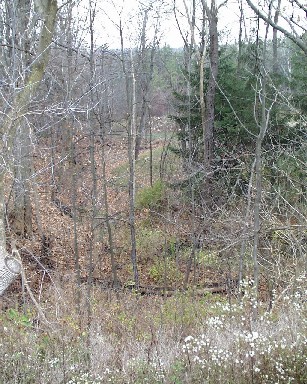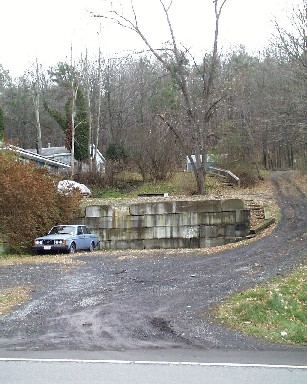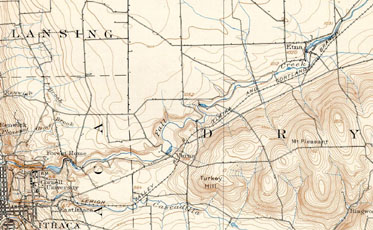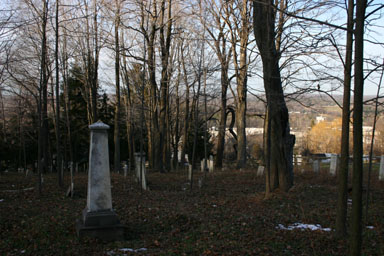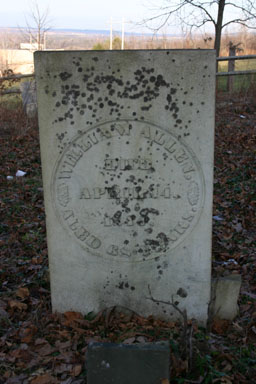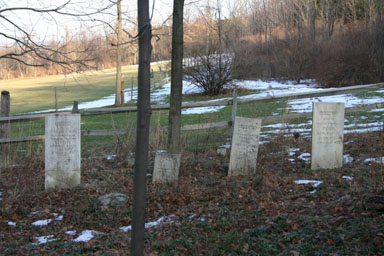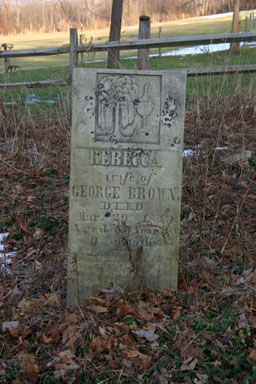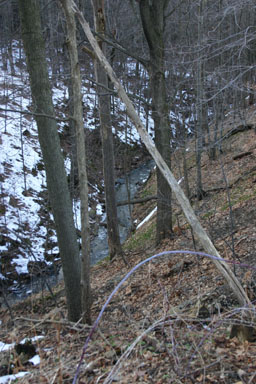December 1, 2003
Density and Water
The Draft Comprehensive Plan makes some suggestions based on water and sewer systems that leave me wondering whether water and sewer are a blessing or a curse for a community. Given the taste of the water from the (barely functioning) well we still have, I'm very happy to have water to my house; the questions are a little bigger than that, though.
I was surprised to see how little of Dryden actually has water and sewer service (map, 302K). The Villages have service, the area between Varna (from about Stevenson Road) to the east-west part of Hanshaw Road and Route 13 has service, and there are a number of small systems. I really would have thought the Ellis Hollow area would have water, but I guess all those new houses are on wells and septic.
Last year, I paid about three times as much in taxes for the Turkey Hill Water and Sewer Districts as I pay in actual water and sewer bills. I need to look into how those taxes work sometime, but I'm guessing that's behind at least part of the reluctance to put water and sewer lines in throughout the town.
The benefits of that water, apart from flavor, however, aren't too clear. There seems to be this notion that water infrastructure should be an invitation to high-density development:
The residential development density proposed for the hamlet areas is an average of 8 dwellings per acre. As with the Suburban Residential areas of the future, the Hamlet areas would be comprised of several types of residential zoning districts with varying maximum allowed densities. Allowable lots size may be as low as 6,000 to 8,000 square feet where municipal water and sewer service are provided. (54)
I'm not sure what Varna's current development density is, but I suspect it's less than 8 dwellings per acre. Eight per acre seems more typical to apartment complexes and maybe townhouses than it does to the indvidual homes which still dominate the Varna landscape. To me, this seems like an invitation to turn Varna into a collection of apartment complexes and duplexes like the "Lucenteland" zone centered on Salem and Briarwood Drives in the Town of Ithaca.
Worse, this recommendation doesn't seem to recognize that recent developments in Varna combine small areas with lots of automobiles. Apartment complexes to the east, west, and south of Varna combine density with dangerous approaches to Route 366. It's great that people living there have water, but unfortunately we have to share ever more crowded roads as well.
As much as I'd like to see Varna get a 30mph zone and a "main street" approach to Route 366 instead of the current ever-widening highway, I suspect the combination of this plan and New York DOT resistance to treating Route 366 as anything other than a traffic corridor will mean that we end up with higher densities of automobiles traveling in ever more dangerous circumstances.
(It's worth noting that the plan also proposes significant expansions of water and sewer service (map, 315K), mostly around Etna, the Village of Dryden, and northwest of the Village of Freeville.)
Density can be a great thing, done right. I'd love to see Varna have a vibrant core with lots of pedestrians and stores accessible by car and by foot. I don't see much sign that increasing density to eight units per acre wherever there's water is likely to achieve that result.
Maybe the folks on Ellis Hollow are smart to stick with wells and septic systems. I wouldn't have guessed that result until reading this.
311 System
Tompkins County has a 911 system for emergency calls, letting people contact a single number for coordinated help with whatever emergency problem they have. 911 seems to have succeeded pretty well overall, though making the change from individual numbers for particular responders to a single call center is a complicated process.
Today's New York Times (registration required) has a piece on New York's 311 system, which uses the same approach for non-emergency calls. New York's bureaucracy has long been considered pretty byzantine, and setting up a single call center for all of these questions sounds like it was pretty difficult, with a few entertaining errors along the way. (Fortunately, non-emergency errors aren't nearly as big a problem as emergency errors.)
Even here in Tompkins County, figuring out who to call about what can take some time spent perusing the phone book and making calls. Last winter we woke up to the sound of screeching tires followed by a soft thud. Somebody hit a deer and apparently kept going. The deer was next to the foot of our driveway in the morning, frozen solid. This hadn't happened before, and no one came to pick up the deer for a week or so. I called the Town of Dryden Highway department, which told me Dryden Road wasn't their responsibility and that I should call the county. So I called the county. The operator started to take my information, then realized I lived on a state road, so she told me to call the DOT. I started laughing and told her the Town of Dryden had passed me here, and she said she'd call the DOT herself, which was great - and the deer vanished the next day.
311 is interesting for reasons that go beyond convenience, though. New York is using it to collect statistics on which problems irk citizens the most, and using that data to direct more resources to common problems. It became clear that some departments had overlapping responsibilities, and they were able to set priorities for handling issues. It also seems like patterns emerge over time regarding the services people need, especially because people can call 311 without knowing precisely what they're looking for.
I doubt this will happen here any time soon given the current state of the budget, but it seems like something that might well lower costs and provide better services in the long run.
December 2, 2003
County budget cliffhanger tonight
The Ithaca Journal offers analysis of what might happen at tonight's county budget meeting, after the rejection of the proposed budget two weeks ago.
Cluster subdivisions
After spending the past few days talking about things in the Draft Comprehensive Plan that worry me, it's probably a good idea to talk about things in the plan that intrigue me.
The discussion of Cluster Subdivisions on pages 50-52 of the plan is interesting. Cluster Subdivisions "provide for an alternative method for configuring building lots, dwellings, roads, utility lines, and other infrastructure in order to preserve the natural and scenic qualities of open land... The purpose of cluster subdivision design is NOT to increase site density, but to preserve open space and reduce the amount of road, water, sewerage, and other public infrastructure needed to be built and maintained to serve residential development."
They include pictures on pages 51 and 52 which contrast a traditional subdivision with a cluster subdivision, making fairly clear how smaller lots and shared space can produce the side effect of preserved open land and lower costs for infrastructure.
This makes a lot of sense to me - more, certainly, than allowing eight dwellings per acre wherever there happens to be water infrastructure. It takes a lot more factors into account and can be customized on a site-by-site basis. The greater density seems more likely to produce pedestrian-friendly areas, and maybe groups of these things might even effectively create new hamlets.
I also wonder whether it would make any difference for implementing co-housing ideas like Ecovillage, which uses a similar combination of dense housing and open space but doesn't, I think, use a formal subdivision. (Now I'm curious about how they handled that.) I very much doubt co-housing would sweep Dryden by storm, but it might make sense as one possibility among lots of others.
December 3, 2003
Snow day in Dryden; superintendent retires
Yesterday was a busy day for the Dryden Central School District - it started with a surprise snow day, and concluded with the approval of the June 2004 retirement of superintendent Patricia Archambault. Archambault, who's retiring to Florida, noted "My hope is I left it a little better than it was when I started - but the snow days I won't miss."
We've got another surprising bit of snow at the moment - heavy snow that looks on radar like it goes from here to about Trumansburg. Yesterday's snow was apparently lake effect. Today's just seems to be an isolated squall.
County budget passes, 15.8% rate increase
Tompkins County passed a budget last night. Legislators hunted for extra revenue, lowering the tax rate increate from 19.65% to 15.81% without changing spending. The property tax levy is increasing from $25 million to $31 million, 23.6%. (Assessment changes make up the difference, so I'll be paying 42% higher county taxes next year overall.)
In Dryden, legislators Martha Robertson and Mike Lane voted for it, while George Totman voted against it. Lane was plainly unhappy with the budget:
"I am still concerned not enough effort was made on the spending side," Lane said. "Most here want to maintain a level of spending. We made the adjustments in revenue. This legislative board has an obligation to govern, so I am going to support this budget."
Local programs still got cuts, as state-mandated expenses increased 26.3%.
December 4, 2003
Used Books, Creeks, and Typhoid
Dryden has two excellent used bookstores: The Phoenix (on Route 13 near Etna), and Book Barn of the Finger Lakes (on North Road across from TC3). A few months ago, I bought a few issues of New York History, the journal of the New York State Historical Association, from each of them.
I was looking through them again this week, and found an article that has some strong reminders of why paying attention to watersheds is important: "Sending Their Sons Into Danger: Cornell University and the Ithaca Typhoid Epidemic of 1903." (July 1997, 273-308.) There were 1,350 cases of typhoid that year, and at least 82 deaths - in a population of 15,400 residents, including students.
The informed public... regarded the Ithaca epidemic as an easily preventable tragedy, and the event was newsworthy precisely because this type of tragedy way becoming increasingly rare. Newspapers and magazines around the county fueled the scandal by accusing the city and university of gross ignorance and neglect of even the most rudimentary methods of preventive medicine.
As the author goes on to explain, however, the fault wasn't simply with Ithaca doctors - it had deeper roots in water supplies, ownership and management of the water systems that brought those supplies to people, and the boardinghouses where male students lived.
Dryden's role in this drama is primarily as a watershed, through Cornell's use of Fall Creek as a water source and Ithaca's use of Six Mile Creek. Neither of these sources were particularly pleasant:
The Ithaca Water Works Company, established by the Treman family in 1872, was the sole provider of the city's water, which the company obtained from two separate sources - Six Mile Creek and Buttermilk Creek. In 1903, some 2,144 people lived in the drainage area of Six Mile Creek. Of these, 812 lived in villages bordering the creek. Drainage from cesspools, privies, and barnyards in the area flowed directly into the creek. There was no system of purifying the water, except for a primitive crib filter that sifted out pebbles and other large objects.
Fall Creek, which seemed less of a problem during the typhoid epidemic (perhaps because Cornell boiled water served on campus), was hardly in beautiful shape either:
As early as 1880, Cornell President Andrew Dickson White suspected that the water from Fall Creek was responsible for illnesses among students and faculty members, and requested that Profs. A. A. Breneman [and others...] survey the conditions along Fall Creek. Breneman reported extremely hazardous systems of sewage and waste disposal bordering the creek. Residents of the Fall Creek area, stung by the report, demanded Breneman's dismissal. Most of them obtained their water from private wells, and they ignored requests that they clean up the area along the campus water supply...
The situation became so grave by 1902 that Cornell officials enlisted the New York State Commissioner of Health, Dr. Daniel Lewis, to help regulate the sanitary conditions of the university water supply. Lewis drew up a list of rules and regulations, which prohibited inhabitants along Fall Creek and its tributaries from depositing any sort of refuse of excrement in the creeks, and from building any privies, cesspools, or sewers along Fall Creek or its tributaries. These regulations were not widely observed. During the 1903 epidemic, Cornell scientists and state health officials found numerous violations of sanitary regulations and discovered a high concentration of intestinal bacteria in the Fall Creek water supply. A resident of one of the towns bordering Fall Creek even offered to sell Cornell "adequate and pure" artesian well water at a cheap price if university officials would continue to overlook the fact "that they use the flow of water to sewer their [water] closests into Fall Creek."
Both the City and Cornell wound up installing filtering plants, and the City bought out the Ithaca Water Works. The City of Ithaca still uses Six Mile Creek as its water source, and Cornell still uses Fall Creek. Water service in Dryden itself seems to come from either wells or Cayuga Lake.
A few more houses
Continuing along Dryden Road/Route 366, there are houses on both sides of the road, some close to the road and others nestled in the hillside.
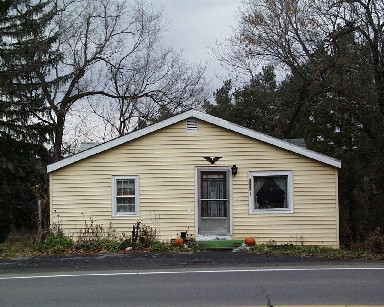
1222 Dryden Road (map)
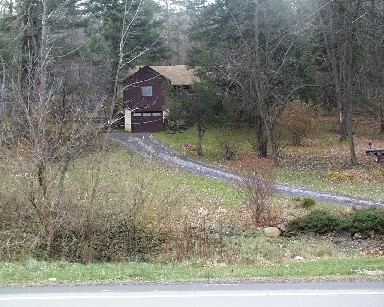
1217 Dryden Road (map)
December 5, 2003
Weather for hamlets and crossings
The Ithaca Journal has an article from David Nicosia of Binghamton's National Weather Service office on their efforts to provide more detailed forecasting, especially where changes in elevation make a big difference. They've put up an experimental site that provides access to this more location-specific forecasting, and they seem to have reports for all of the following places in or right on the border with Dryden:
- Besemer (map)
- Bethel Grove (map)
- Dryden (map)
- Ellis (map)
- Etna (map)
- Freeville (map)
- Hibbards Corner (map)
- Howland Corners (map)
- Lacy Corners (map)
- McLean (map)
- Peruton (map)
- Red Mills (map)
- Varna (map)
- Willow Glen (map)
No entries for West Dryden or Malloryville, but very impressive.
December 6, 2003
Tough day for travel
It is my peculiar misfortune to have to get to Philadelphia today, as snow blankets the northeast and Tompkins County. We're kind of on the edge of the storm here, but I just shoveled away about three inches. (The snowblower won't start, of course!)
I'll be driving from here up 13 through Dryden and Cortland before turning south, as it seems wise to stay on the largest and flattest roads possible. (Normally I'd go across Turkey Hill, Quarry, Snyder Hill, and Besemer roads to 79, or take 38 to Owego.)
I'll be away until next Friday (thereby missing the Varna informational meeting on the Draft Comprehensive Plan, which annoys me thoroughly), but I plan to keep this blog going daily.
December 7, 2003
Earliest days
I've been writing about current events and possibilities for the future outlined in the Draft Comprehensive Plan, but I think it's time to listen to George Goodrich about the past again. In this first chapter of The Centennial History of Dryden, he outlines the terrain that still largely defines plans for the town.
Chapter I - Prehistoric Conditions
The complete history of every atom of matter extends back to its creation; so the early history of the territory now known as the town of Dryden, is coeval with the formation of the present surface of the earth itself. While the scope of our work will be mainly confined to the century period immediately following the first settlement of the township by its present race of inhabitants, a brief reference to the earlier conditions will here be permitted, bringing it down to the time when our History properly begins.
Our knowledge of the earth's early history must be principally derived from the science of geology, which teaches that this portion the state of New York was once the bottom of an ancient ocean, of which the sea shells and fossil fishes, found in the stratified layers of our native rocks, and the extensive beds of salt which are now known to underlie the surface of certain sections, if not all of our county, seem to offer abundant proof. Scientific scholars tell us that the northern part of our state first emerged from this prehistoric sea, which, gradually receding toward the south, left bare the native stratified rock formation of our locality in what the geologists term the Chemung period of the Devonian age. They teach us that subsequently powerful forces, by means perhaps of icebergs and glacial action, brought here and scattered about boulders and gravel beds from older and more northern geological formations, at the same time plowing up and pulverizing into soil the native strata, in some places so deep as to form the beds of the numerous lakes which are a marked physical feature of Western New York. These lakes and valleys, with their intermediate ridges of hills and uplands, usually extend in a general north and south direction, the hills of our township varying from 1500 to 1800 feet above the present sea level, while the beds of some of the neighboring lakes, Seneca, for example, lie below the surface of the ocean itself. Just how these results were brought about must still be a matter for scientific study, but certain it is that that this process of creation or development, whatever it may have been, resulted in leaving a rolling surface and a deep and fertile soil covering the beautiful hills and dales of our county of Tompkins.
When first discovered by civilized man our town was a dense forest mostly of hemlock and hard wood timber, liberally sprinkled with large trees of white pine, which in some places grew to be so thrifty and thick as to monopolize the soil and overshadow and crowd out the inferior growth. How many generations of these undisturbed forest trees grew and decayed before being seen by the first settler is a matter of pure speculation; how this primeval forest appeared to the hardy pioneers who cleared it from the sites of our present homes, must be to us a subject for interesting reflections.
The physical features of the country which have suffered the least change in their appearance during the century period of our history, are the larger streams, which, "while man may come and man may go" still "flow on forever" from their fountains to the sea. When first discovered, Virgil, Fall, and Cascadilla creeks, although unconscious of their present names, with more obstructed channels but with larger volumes of water, drained the same valleys through which they still flow. They were then in their wild, untrained, and unbroken state, unsaddled by bridges and unbridled by mill dams, but they took the same general courses which they now pursue, and were the first landmarks in the boundless forest. The hills, too, although hidden from view by the foliage of the unbroken shade, must have presented the same general form as now. Our Dryden lake, since enlarged by artificial means, still had an existence as a small body of water, when nature turned it over for the use of man. For unknown ages, its tiny waves broke on the lonely shore, or in more placid mood, its calm surface, all unseen, reflected the shadows of the virgin forest of pine with which it was completely surrounded.
Goodrich, George B. The Centennial History of the Town of Dryden, 1797-1897. Dryden: Dryden Herald Steam Printing House, 1898. Reprinted 1993 by the Dryden Historical Society. Pages 1-3.
(The Dryden Historical Society, which sells this book, may be reached at 607-844-9209.)
December 8, 2003
A dense Ithaca
George Frantz, of the firm creating the Dryden Comprehensive Plan, has an editorial in the Ithaca Journal today about visions of a much more compact Ithaca at Cornell's Urban and Regional Studies program.
He's right that the distributed "American city that has evolved since 1900 is in fact a historical aberration," and that we don't need to be sprawled across the countryside. At the same time, I suspect that encouraging more compact development is going to have some very unpleasant side effects for denser areas while transportation by car remains a critical part of American expectations.
I'd love to see the hamlets and villages in Dryden support more people and businesses on their own, but the drive to Lansing, Ithaca, and Cortland is just too easy right now. This isn't a new problem; George Goodrich wrote back in 1897 that:
The advent of the Southern Central railroad in 1869 has already been referred to and produced no great immediate change in the affairs of the village. To the merchants the advantage of reduced freight rates was offset by the ease and frequency with which their customers sought places in larger towns to do their trading. (The Centennial History of the Town of Dryden, 1797-1897, p.96)
(I'm in Philadelphia for a conference at the moment, enjoying that I can walk around its dense center city and find all kinds of amazing shops while my car rests in a garage for the week.)
Cakes and coffee
Cathy Wakeman reports in her Dryden Town Talk that Googer's Bakery and Coffee Shoppe will be opening today at 22 West Main Street. I've enjoyed the food at Googer's Cakes and Things on Route 13 very much, and I look forward to trying the new place. It also sounds like they have lots of plans for being a social center.
Wakeman also provides a calendar of holiday caroling and concerts.
Also, the Tompkins County economy seems to be doing okay. To some extent, that's because we don't make things here, which feels kind of odd.
December 9, 2003
Comprehensive Plan Meeting tonight - Varna
There is a public information session about the Draft Comprehensive Plan at the Varna Community Center (map) tonight from 7 to 9 PM. Unfortunately, I can't make it, being a couple of hundred miles away.
The counter on the page for the draft plan is only at 118, which is depressing. I worry that I'm about fifteen of those hits. Hopefully it'll reach more people tonight. The Ithaca Journal has an article that describes some of what's involved.
There are also sessions in Freeville this Thursday and Dryden next Thursday.
December 10, 2003
Report on Comprehensive Plan session in Varna
I couldn't make it, but I'm happy to read that three dozen people showed up for the Varna informational meeting on the Dryden Draft Comprehensive Plan. It sounds like the tough questions about increasing density in Varna while having no guarantee that the road will be changed to make pedestrian life possible were asked, and hopefully they'll have an impact.
The Journal also has an editorial encouraging people to participate in the planning process. For once I'm in simple and complete agreement with them. One sign that more people are getting interested is the counter at the bottom of the Draft Comprehensive Plan page - it's at 199 now, up from 118 yesterday. That's an encouraging step up in pace.
The next informational meeting is in Freeville on Thursday, at 7pm.
December 11, 2003
Schools, small business, traffic
It's another quiet news day for Dryden, but there are some interesting pieces in today's Ithaca Journal. The Dryden School Board approved stipends and held off on a contract for review. The headline of the story seems backward relative to the article contents.
Further afield, there's a piece on Senator Clinton promoting micro-enterprises (of less than five people) in New York, something that seems worth encouraging in Dryden. Also, the director of Cornell's Transportation and Mail Services has a guest column on how Cornell manages its parking and commuting, a task which has a direct impact on the traffic flows on Routes 13 and 366 through Dryden.
December 12, 2003
I'm back
At 6:19 pm, I crossed the Dryden town line on Route 38 coming from Harford. I barely had time to enjoy that I was finally home before the world went white with snow and I had to slow down to 20mph. It was slow all the way to the Village of Dryden, and I got to skid along at 5mph as I approached the intersection with 13. There was lots of snow until I reached the 366/13 intersection, and suddenly the sky was empty and the ground dry.
Philadelphia was great and the conference was very good, but it's wonderful to be home.
Extra, extra - read all about a county executive?
The Ithaca Journal tends to post the contents of their paper to their web site once a day, and I've not seen very many "news updates". It's a little surprising to see one posted this afternoon, reported without any contrasting quotes, on a topic that doesn't exactly need to be rushed to the presses.
Tompkins County Republican Chairman Mark Finkelstein held a press conference proposing that the county end its current use of a chairman elected from among the legislative representatives and replace that with a County Executive, elected by the entire county. Whatever the merits of an executive system, it's hard not to see this as an acknowledgment that the Republicans aren't likely to win another chairmanship in a long time given the 11-4 Democratic dominance on the legislature, combined with the recognition that Republicans have done slightly better at elections for countywide office than their numbers on the county legislature suggest.
I suspect this particular article matters mostly to whatever few people read the Journal's site late in the day, but hopefully tomorrow they'll publish something that explores the issues in depth rather than just citing one Republican without other perspectives.
Update: As of 7:15am Saturday morning, the Friday news is still up but the "news update" is gone. I wonder if this was just some kind of glitch.
December 13, 2003
More on the County Executive notion
The Journal now has a more complete article on the County Executive proposal made by Republicans yesterday.
It's hard for me to see the point, and citing Chemung County as an example of how a government should run doesn't impress me much. G. Thomas Tranter parlayed the executive position into close ties with Pataki and D'Amato (and eventually a job at Corning), but also grew a county with a sick city and dull sprawl surrounding it. It's also hard to be surprised George Dentes is still complaining about a budget process that didn't give him everything he wanted.
Political transitions
The Journal also has an article today on the volunteer fire departments and the transition from the current board to the all-Republican board elected in November. A few pieces of it really struck me.
The Etna Fire Department is still refusing an audit, and Republican councilman Steve Stelick confirmed outgoing Supervisor Varvayanis' comment that ""I don't believe there'll be a contract unless they get audited," saying that "What it means is nothing right now but it's going to be a point of contention next year. Both Chris (Michaels) [another Republican councilman] and I are adamant on this point."
I'm reminded a bit of the minutes for the June 11, 2003 board meeting, where we heard:
Cl Michaels reported that he and Cl Stelick and Atty Perkins had met with Neptune Hose and their attorney yesterday. He said that the meeting did not go well and their attorney was uncooperative... Cl Michaels said it seemed that everything was wrapped up, and although he sensed a decent amount of cooperation from individuals at Neptune Hose and their board, he found it very difficult to work with and discuss the matter with their attorney. He said he left the meeting very discouraged about how things went for the meeting, given all the work he and Cl Stelick had put in trying to work toward developing a relationship with the chiefs of the departments. He felt it was a step backwards.
It's hard to believe that the fire department issues are simply going to disappear when a lot of the participants are still around and issues remain. I wish the Town Board and the fire departments luck in sorting this out, but have to admit some strong doubts about the "Democrats hate fire departments" theme that the Republicans used in the last election.
The other striking note was that Varvayanis has only met with incoming supervisor Steve Trumbull for an hour or so plus a Bolton Point water meeting, and notes "I know he's met for four or five hours with the town attorney [Mahlon Perkins], so he should be up to date on the projects if not the procedures." It seems like an odd way to manage a transition.
Freeville Comprehensive Plan Meeting?
I've been away all week, so I didn't get to attend either the Varna or the Freeville informational meetings on the Draft Comprehensive Plan for Dryden. The Varna meeting seemed pretty well-covered in the paper, but I've seen no similar coverage for the Freeville meeting. I'm especially curious what people thought of the plans for encouraging development to Freeville's northwest.
If you were there, and don't mind sharing, please leave a comment.
Yet more houses
This weblog looks a bit bleak without pictures, so here are a few more houses and a view off the side of the road.
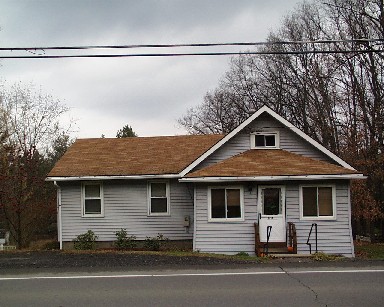
1214 Dryden Road (map)
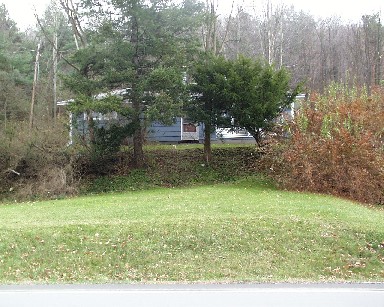
1211 Dryden Road (map)
December 14, 2003
Morning with Maps
Despite my sniffling, sneezing, and coughing, I've been enjoying something new I got for work - Manifold GIS software. It's a map viewing and creation tool that lets me get right into the map data published by people like the US Geological Survey, New York State, Tompkins County, and the US Census Bureau.
As much as I like the maps in the Draft Comprehensive Plan, it felt like there were a few maps missing, like ones indicating current population densities. Hopefully - as I learn how to work this thing and where best to find data - I'll be able to make my own while familiarizing myself with this tool.
Comparative tax rates
The County Department of Assessment maintains files of current municipal tax rates and current school tax rates. I wish they also included historical information so I could examine the rate of change, and numbers for the total levy (not just the rate) would be helpful too. Guess I'll have to go down there sometime and see what I can find about past rates.
They also have information about how neighborhoods are defined for assessment purposes. They purport to have maps for the county, including Dryden, but the links are broken. (Update: I emailed about the broken links, and they speedily fixed them 12/15.)
(Tax maps identifying parcels are here, but that's a different set of maps.)
December 15, 2003
The news is snow
The news yesterday into this morning was snow, and lots of it. I removed about three inches from the driveway yesterday at 4pm and a foot this morning.
When I'm making the first run with the snowblower (which now works, though nothing's changed) through the right kind of powder, bubbles pop on the surface of the snow on the left hand side of the machine. It only works for that first pass, but it's something to look forward to when there's lots of work to be done.
December 16, 2003
What's up at NYSEG?
The building I refer to as "NYSEG headquarters" looms everytime I drive home along Route 13. It's an enormous complex, and dominates the overlapping area of Routes 13 and 366. The "Utility Headquarters" sign indicates a left turn lane just for it, and it has multiple entrances and exits into this intersection area.
It seems to be less and less a headquarters, though. I can find a 1993 document which describes NYSEG as "a New York corporation with its headquarters in Dryden, New York", but then I find things like "The headquarters of RGS Energy, RG & E, and NYSEG will be in Rochester. Operating headquarters for NYSEG will remain in Binghamton."
There's a June 5, 2003 Ithaca Journal story wondering what to do with the building. I can't find it in the Journal's archives through Google, but the Public Utility Law Project has a copy. In it, we find:
Company employees and government officials have known for months that Energy East, NYSEG's parent company, was moving much of its New York corporate operations to a facility north of Portland, Maine. On May 23, an intra-office memo said that the first job announcements would be made in July.
The jobs of approximately 230 union workers won't be affected by the move, the memo said. But there's still no word from the company how many of the remaining 170 non-union employees would be relocated or laid off.
Officially, NYSEG and Energy East has declined to comment on details of its move, other than to say consolidating its accounting, finance and treasury operations with its information technology department in New Gloucester, Maine, stands to save the corporation millions of dollars.
Or, as Michael Lane put it:
Mr. Lane said according to recent reports in the media, Energy East continues its economic ravishment of Tompkins County. He said there have been several attempts to contact Energy East and NYSEG about their plans for their facility and jobs in Tompkins County. He said Mr. Joseph, Chair, wrote a letter to Energy East in an attempt to hold a meeting; however, Energy East was not willing to communicate on the matter. There have also been attempts by Tompkins County Area Development to hold a meeting which have also failed. Mr. Lane said yesterday Energy East announced it will be consolidating its operations and headquarters in Pine City, Maine which will place a lot of jobs in Tompkins County in jeopardy. Mr. Lane assured residents that although they have not been effective, there has a been a significant effort by Tompkins County to open negotiations with Energy East.
I've kept an eye open for further news on this, but haven't seen anything, and my searches haven't brought up much. The Journal article does include some hope for future development of the site:
As far as location goes, it's really dynamite," said Robert Lama, a commercial real estate broker in Ithaca.
"It's right on Route 13 at the north end of the Town of Ithaca, it's close to Cornell, it has a lot of possibilities," Lama said.
The Draft Comprehensive Plan doesn't talk at all about this situation. I'm not sure that it can address it directly, but as it's one of the more prominent buildings in Dryden, it might be worth contemplating. I hope that the NYSEG building doesn't turn into a remainder of dreams past, darkening the thoughts of those driving by like the old Ann Page plant has done in Horseheads.
If anyone knows more, please leave the latest in comments.
December 17, 2003
Dryden teachers deadlock continues
It looks like the Dryden Faculty Association will be working without a contract for a while longer, as a meeting with a fact-finder produced no new results. Superintendent Patricia Archambault estimates that this will continue into February or March.
Meanwhile, Ithaca City School District Superintendent Judith Pastel received a 3.2% raise.
More thoughts on NYSEG
After writing about how NYSEG's headquarters building seems to be in steady decline yesterday, I started thinking about how it's always been a strange island anyway. While it dominates the Route 13/366 intersection, it doesn't feel like it's actually contributed that much to the area's development.
I suspect the gas stations may benefit slightly as employees fuel up and buy snacks, and maybe Lockewood Interiors and HEP have sold kitchens to people who work there, but there's really not much spillover from there. There aren't local restaurants catering to a NYSEG crowd (though maybe the Plantation Inn still serves lunch). It doesn't have any of the kind of spillover effects that Corning Incorporated has on downtown Corning, for instance, though admittedly Corning occupies a much larger complex in a different setting and creates different kinds of effects.
NYSEG does seem to have been designed as an island, though. It seems at one point to have had a hefty private water system, described in the first resolution of this meeting, where we find:
WHEREAS, New York State Electric and Gas owns a facility on Lower Creek Road in the Town of Dryden, formerly used for treatment and pumping of water from Fall Creek to the Route 13 Headquarters, and
WHEREAS, NYSEG discontinued the facility's usage in 1989 and has since attempted to unsuccessfully to market the site, and
WHEREAS, the plant's creek intake piping and double tank storage system hold potential for use by local fire departments for tanker shuttle operations, and an inexhaustible water supply could be established at the site for use by all area departments, and...
I'm guessing they joined the Town water supply at some point, as they're shown as part of it. I also understand they have a company cafeteria, which may help explain the lack of surrounding restaurants. (It may explain to some extent the Fine Host facility down the road as well, of course.)
The Draft Comprehensive Plan talks about encouraging industry in the Route 13/366 intersection area, and also:
In addition to light industry, the areas proposed for future industrial development could also accommodate the development of office buildings that could house corporate administrative operations and service enterprises. Research and development enterprises such as computer software and equipment design businesses are another type of use in these areas.
Maybe this time around Dryden could encourage these things to develop in ways which aren't dependent on a single company, and in a more open style which would create more shared advantages that could encourage additional companies to locate here. Right now, it's hard to imagine how there's any kind of advantage to locating near NYSEG. It'd easier to imagine the advantages of locating in the same place if it had a group of active companies operating in a place where you can take visitors for lunch without driving for miles.
December 18, 2003
Fire, accidents along edges of town
Emergency crews were busy yesterday through yesterday's snow with a fire in McLean and a fatal accident on 34B, plus a 3-car accident on 13 near the airport.
Dryden Comprehensive Plan information meeting tonight
The last of the informational meetings on the Draft Comprehensive Plan will be held tonight from 7 to 9 PM at the Dryden Town Hall, 65 E. Main Street (map).
I'll be at this one, finally!
Hydroponics
Ever wonder what the brightly-lit greenhouse across from the NYSEG building is?
The NYSEG site has information on various projects they're supporting, including a PDF on Controlled Environment Agriculture. They're growing Bibb lettuce in there, apparently, and you can buy that lettuce at Wegmans. I haven't seen it anywhere else yet, though.
NYSEG is also supporting a fish farm in Groton that appears to be expanding.
Map sources
Before tonight's informational meeting on the Draft Comprehensive Plan, I asked George Frantz, the planner, why the GIS versions of the maps weren't available. He said he's not allowed to redistribute maps made by Tompkins County. I said a lot of it was available on the Web, and I was mostly right, but not completely.
There's a lot available directly from the GIS department, no questions asked, but it's not the road maps, town boundaries, or tax maps. Most of the maps I've been playing with have been ones from CUGIR, Cornell's immense library of GIS resources for New York State. Census maps provide boundaries, roads, and a lot more. The one tax map I'd been playing with is PDF, not a separate drawing layer. Workable, though inconvenient, especially as Dryden has lots of tax maps.
The one piece that I'm really missing for comparison with the draft plan's maps is the tax maps (no need for ownership information) - guess I'll have to ask about getting those. I'm not entirely sure why they post material in PDF without corresponding GIS work files. Most people are fine with PDF, I guess.
Update: To correct myself yet again, the information is available, though it's through the CUGIR site (click on Tompkins, and then scroll down the list), not directly through the county office. The tax parcel map for the whole county is especially impressive.
December 19, 2003
Annexation hearing, water important
At last night's discussion of land annexation by the Village from the Town of Dryden, adding water services to the parcel seemed to be the main reason people supported it - beyond the underlying purpose of putting a state DOT facility there. Questions about the likely tax-exempt status of most of the land and concerns about the facility itself also came up.
In other water-related news, the City of Ithaca moved forward on a wastewater agreement that should simplify things for the Town of Dryden as well as an intermunicipal wastewater agreement that affects Dryden, Ithaca, Lansing, and Cayuga Heights.
Draft Comprehensive Plan Informational Meeting
I made it to last night's informational meeting on the Town's Draft Comprehensive Plan, held at the Dryden Town Hall. (The hearing on annexation was at the Village Hall, at the same time, and there was a bit of confusion.) There were about 25 people at the start, and probably 35 people total were there at some point.
Barbara Caldwell explained the format, and then George Frantz gave a 45-minute presentation.
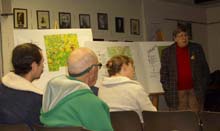
Barbara Caldwell introduces the session
Frantz's presentation was a brief description of the contents of the Draft Comprehensive Plan, noting the goals of the process, the current state of the town, and some of the things they hope to achieve as a result. The town is growing, but not that rapidly, so there's both a need to control growth and an opportunity to do so. Agriculture and open spaces were near the top of the priority list, and increasing the density of existing residential areas to make most efficient use of infrastructure fit nicely with that, as did plans for more parks and the use of cluster subdivisions.
The questions people had, though, made it fairly clear that achieving those goals is going to require a complicated balancing act. I didn't take names of the people asking, but questions included:
- Where low-income multiunit housing would go, if Dryden was asked to provide for it.
- How much of the water and sewer work would be new. (It would depend on demand.)
- How the value of agriculture squares with putting "suburban residential" labels over an area to the west of Etna that currently includes farms.
- How these guidelines would interact with tax laws, payments for development rights, etc.
- Concerns about residential creep around Dryden Lake, and warnings that low-density housing there just produces mansions.
- Whether the "main street" proposal for Varna is anything but a figment, given the DOT's focus on traffic. (This was mine; apparently the DOT would have to recognize the plan, and they've had some kind of "sea change", but I can't say I'm convinced.)
- The existence of a housing shortage in Tompkins County right now, producing 14,000 commuters a day and steadily rising assessments.
- How cell towers fit into the plan, and whether a moratorium on them would be a good idea.
- Concerns about the "Route 13 overlay" area, which already has dangerous traffic and uncoordinated uses.
- Concerns about whether preserving open space through things like the Nature Conservancy would drive taxes up by pulling land off the tax roles.
They collected all of the comments, and tried to answer many of them.
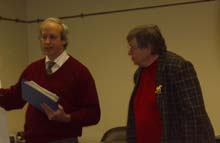
Barbara Caldwell and George Frantz answer questions about the plan.
Some of the questions seem likely to require reconsideration of the plan, though a lot of them also interact with tax, zoning, and policy questions that are only likely to be addressable as the plan moves toward implementation. Some of the questions had serious emotional heat, especially around the Dryden Lake issues and farming. This quote, from someone whose farm is now labeled for suburban residential development, is pretty powerful:
"I can't just pick up my 25 acres and put it into one of your green spots... so you're saying my overall plan should be to screw the farm and the animals, and subdivide?"
I'll be very curious to see what the next draft of the plan looks like.
December 20, 2003
Schools, dispatchers
The Ithaca Journal notes this morning that the Ithaca City School District is still working out elementary school redistricting, and mentions Turkey Hill Road in particular as a place where some students go to Caroline and others to Cayuga Heights. It was very confusing when we bought this house that realtor.com kept claiming it was in Cayuga Heights because of the school.
There are also a Laurel and a Dart related to the recent Dryden renovation referendum, and what feels like an oddly truncated piece on consolidation of emergency dispatch operations for the county.
December 21, 2003
More houses
These are three more houses along Dryden Road/366. Yes, I took the pictures before the snow (which now feels like a permanent feature) arrived.
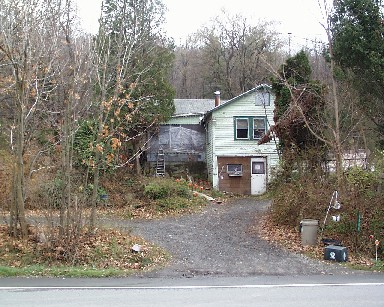
1207 Dryden Road (map)

1204 Dryden Road (map)
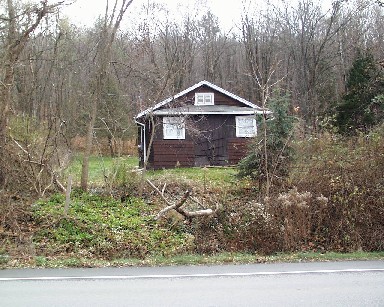
1203 Dryden Road (map)
Mobile homes
While the Draft Comprehensive Plan notes the existence of mobile homes in Dryden, it doesn't talk much at all about their future. It recognizes that:
Manufactured housing (a.k.a. mobile homes) accounts for a significant proportion of the housing stock. There are an estimated 1,150 manufactured homes in the town, of which approximately 890 are located within 17 mobile home parks.
In Varna, the Hillside Acres park contributes substantially to the existing density of the place. While the hamlet along 366 is packed fairly tightly, the park is mostly smaller mobile homes on small plots of land.
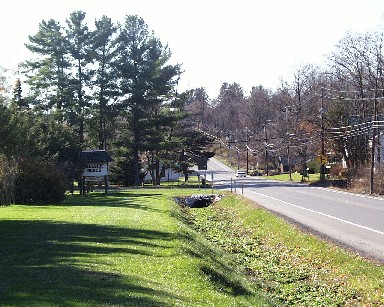
Looking toward Hillside Acres in Varna (map)
Mobile homes and mobile home parks are a fairly distinctive sign that you've entered the Town of Dryden from Ithaca, especially along Game Farm Road, Route 366, and Hanshaw Road. (The same thing happens when you leave the Town of Ithaca and enter Enfield or Newfield.)
Mobile homes occupy an important role in housing generally. They provide low-cost housing to lots of people and a way for them to accumulate equity in their homes, especially when they own the property on which the mobile home rests. They're frequently held up as an example of how the market can provide housing for people with lower incomes without the need for government intervention, though there are both cases of government intervention (HUD certifications for construction) and some fairly ugly stories of the market treating people badly.
Wheel Estate: The Rise and Decline of Mobile Homes, by Allan D. Wallis (Johns Hopkins University Press, 1990, Amazon) provides a thorough history of these houses, from the days when Hammondsport native Glenn Curtiss built them as luxury travel to their current lives as recreational vehicles and permanent housing.
Mobile homes have created a lot of issues over the years. One of the first ordinances in the zoning amendments packet the Town hands out with the zoning regulations, passed in 1989, bars mobile homes without HUD certification (pre-1976 houses) from being used in the town except where they already exist, even if they're used to replace an existing uncertified home. The last amendment in my copy is from 1998, and strikes the clauses permitting mobile homes in R-B-1, R-C, and R-D zones, huge swathes of property.
It looks like Dryden has effectively ruled mobile homes out for large parts of the town, but still has lots of them and lots of parks. What should the future of the parks be? They're an effective source of housing for people with lower incomes, they provide the kinds of densities that the Draft Comprehensive Plan seeks, and yet they're not mentioned at all in the sections looking forward.
While it seems unlikely that a developer will want to buy up parks in Dryden and redevelop them for other purposes, it's a real problem in a lot of parts of the country. When the money to be had from renting land and providing services to mobile homes isn't as good as another option, owners frequently sell. The laws don't provide much protection for the residents of the mobile homes, as the laws take the designation "mobile" seriously. But where can people take their homes, even if (a big if) they can move them? This might be an issue better discussed as part of a planning process rather than hoping the problems never arise.
Even if the official policy on mobile homes is to discourage them and hope for the best, some discussion of how mobile home parks fit into the planning for new water districts might be a good idea, as a lot of the area highlighted in Proposed New Water & Sewerage Service Areas, particularly the area west of Etna, already includes mobile home parks.
December 22, 2003
Red hats and cropland
Cathy Wakeman reports the formation of a Red Hat Society. Requirements for membership are "being an older, retired woman, and wearing a red hat". She also reports on the Dryden Senior Citizens and the Christmas dinner at the Dryden Veterans Memorial Home.
In other news, the Tompkins/Schuyler County Farm Service Agency (FSA) field office is taking applications forthe Conservation Reserve Enhancement Program (CREP). Under the program, the USDA will pay rent to farmers who take environmentally sensitive land, especially that next to waterways, out of row crop production. Crops in those areas will be replaced with grasses and hardwood trees to reduce erosion and runoff.
December 23, 2003
Adult businesses
I pulled out my Town of Dryden Zoning Map (available at the town office - I haven't seen it on the Web) to compare it to the Future Land Use Plan, and was reminded of a a feature on the zoning map that isn't mentioned in the Draft Comprehensive Plan: the M-AA district.
The functioning of this zone, which includes 84 Lumber and nearby parcels, is described in the supplement that comes with the Zoning Map:
Supervisor Schug explained that this was a public hearing to establish an M-AA Zone. The M-A Zone has two zones with the town that allow for business, heavy industry, and so forth. The M-AA Zone would allow adult entertainment within that zone. Supv Schug explained that the proposed change had been published in the newspaper and Attorney Perkins paraphrased the amendment for those in attendance.
Atty Perkins - The proposed zone will cover all of Town of Dryden tax parcels 42-1-9.1, 10, and 12 and those portions off 42-1-2 and 11 lying north and east of Route 13, which basically is west of Hanshaw Road and north of Route 13. The amendment prohibits adult uses is all of the other zones in the Town of Dryden except the new M-AA zone. It adopts a new Section 1200 subdivision 2 stating that the intent and purpose of the M-AA zone and the following regulations is to establish and identify specific area where adult uses will be permitted and to establish regulations protecting nearby neighborhoods from the impacts of such uses, and separating such uses from non-compatible uses such as residential uses, schools, churches, and parks.
The Ordinance is amended by adding a new Section 1202 entitled Adult Uses. Subsection 1 defines adult use and adult entertainment business and it goes on to allow adult uses in the M-AA zone with site plan review as are all uses in M-A zones subject to specific other conditions. That is, no adult use can be located within 500' of any single family, two family, or multi-family dwelling, 1,000' of any public or private school, 500' of any church or religious facility, 1000' of any public park, and 2500' of any premises licensed by the State Liquor Authority under the provisions of the Alcohol Beverage Control Law. It establishes a method of measuring the distance. It sets forth additional requirements with respect to the interior of adult use buildings with respect to their locations. It requires additional screening at the discretion of the Town Board and prohibits adult uses also in the M-A zones. Effective date 8/11/98.
I doubt this was passed to turn 84 Lumber into a red-light district (though the bright red representing it on the zoning map is an interesting choice.) If I remember right, this was about the time that Sirens was operating across the town line in Groton, where the Elm Tree Inn is now. It echoes the zoning laws New York City passed while Giuliani was waging war on adult businesses. Municipalities without zoning can't regulate these businesses at all, and municipalities with zoning have to provide a place for them if they want to bar them from other areas.
The map for the Future Land Use Plan doesn't highlight the M-AA zone at all. In fact, it chooses an aquamarine color for the industry/office/research zone it would like to see develop there.
December 24, 2003
Willow Glen
Willow Glen (map) is a place that's listed on some maps, but isn't exactly a destination. You can get weather reports for it, but it's not considered a place for purposes of things like the Draft Comprehensive Plan, where it's the eastern part of the "Route 13 Overlay". It's most easily identified as the area with the big cemetery.
Willow Glen seems to have peaked early, and was probably ahead of the Village of Dryden until about the 1820s, with mills, a tannery, and tight-knit community. George Goodrich tells some tales about it, exploring its economic development, the cemetery, and some strange stories about a buffalo and a Prophet.
Chapter XXX - Willow Glen
A stranger now passing through the quiet locality of our town which formerly was known as "Stickles's Corners" but latterly called by the more romantic name of "Willow Glen," upon looking about him would naturally inquire "Where are the willows and where is the glen?" for both are at present a little obscure. It is said, however, that over fifty years ago, when this name was first applied to the locality by one of its inhabitants, Miss Huldah Phillips, the banks of the little stream which flows down through the "Corners" from the hillside were lined with large willow trees, forming with them a glen which made the name very appropriate.
As we have already seen, the settlement of Willow Glen dates back as early as 1798, when three of the very earliest pioneer families of the town located there, and during all of the Pioneer Period it was a formidable rival of Dryden village. During that time, it contained a tannery upon what was afterwards the Phillips corner, a grist mill (one of the earliest in town), and two saw-mills (one of which was the earliest in town, being completed in 1802), upon Virgil Creek, two stores, two distilleries, one hotel, a blacksmith shop, an ashery and a large wagon shop, all constituting a good business equipment for a new country settlement. One by one these elements of business have disappeared, and all which now remains in that line is the old blacksmith shop, converted in these latter days into the factory and storehouse of Mosso's Tempering Compound, and the wagon shop across the way conducted by Andrew Simons. Willow Glen has always had and still maintains a good school, and with it is connected an incident which is still remembered by some of the oldest inhabitants, who were children when the events took place. It is the "Story of the Bison" and reads as follows:
On a certain autumnal Saturday afternoon about seventy-five or more years ago two men entered Willow Glen by the highway from the west, leading between them a wild, shaggy animal, a buffalo recently capured on the prairies, being the first one seen in this part of the country. They stopped at the hotel, then kept by William Wigton, in whose barn they exhibited the buffalo to those who would pay ten cents for the opportunity of seeing him. During the afternoon the school was let out - Saturday was a school day in those times - and some of the scholars had ten cents with which to purchase the privilege of seeing the exhibition, but many others did not, and as an inducement to the owners of the animal the older school boys proposed that those who could should pay, but that all of the school children should see the buffalo; but the proposition was not accepted and none of the scholars were admitted to the barn. As night approached, Mr.Wigton, who had overheard some plans among the boys, who were displeased with the rejection of their proposition, informed the proprietors that he would lock up the barn at night but he would not be responsible for what might happen to the buffalo. They replied that there was no danger that any one would molest the animal for it was all that they could do to manage him and no one else would venture to undertake it.
Matters were left in this way, but in the morning the barn doors were open and the buffalo was gone, no one knew where. There was a long watering trough which extended into the barn and some one during the night had drawn the plug, letting the water out so that he could enter the barn through the empty trough and unfasten the doors from within. The proprietors in vain spent the morning looking after the source of their income, but no track or trace of him could be found.
Early that morning Darius J. Clement, the old gentleman who died a few years ago in Dryden village, but who was then a boy living with his parents where John Card now resides, went out before it was fairly daylight to the barn to do the milking. He returned soon after saying to his parents that he believed the Evil One himself had taken possession of the barn, for such pawing and bellowing, by a large animal with short horns, a large shaggy head, fierce, glaring eyes and a long tail, he had never seen or heard of before. Mr. Clement, who was a very religious man, decided that the Sabbath was no time to investigate the matter and directed that nothing should be done with the animal until the next day. But the news began to be circulated that the buffalo was in the barn of Mr. Clement and the people from all around began to congregate so that by noon all the men and boys from the neighborhood were assembled, and Mr. Clement was very willing that the cause of the disturbance should be removed. Some of the boys, presumably the same who had brought him there in the night, readily undertook the task of removing him and in so doing they led him through a clearing in which a vicious bull was being pastured. No sooner did the bull see the intruder of something like his own species approaching than he came rushing toward them ready for a contest of supremacy. Those who then had charge of the buffalo were very willing to let go their hold, which they did, thereby having the fun of witnessing a Sunday bull fight. The result proved that the buffalo, with his short horns and wild, vigorous habits, was too much for his domesticated cousin, who was was compelled to recognize the superiority of the intruder. The fun being over the boys returned the buffalo to his owners, who went on their way sadder if not wiser men.
Willow Glen, as well as the northwest corner of the township, claims a share in the invention of the power threshing machine, an inventive genius by the name of Miller having there developed one of the first threshing machines ever seen, which, with subsequent improvements, has revolutionized that part of the farmer's labor.
We have as yet failed to secure very satisfactory notes of the pioneer families of Willow Glen. Of the first three families to locate there in 1798, so far as we have been able to learn, the Clausons have no descendants now residing in the town, while Ezekiel Sanford and David Foote are the ancestors of quite a number of the present inhabitants. John Southworth, whose father, Thomas Southworth, came to Willow Glen in 1806, will be the subject of a separate chapter. Joshua Phillips, who owned and perhaps built the tannery on the now vacant corner of Willow Glen, was early a prominent citizen, being a Member of Assembly from this county in 1820 and a supervisor of the town in 1839. He came to Dryden from Nassau, Rensselaer county, about 1806, or, as some say, in 1811, and was a major in the State Militia. His wife, whom he married in Rensselaer county, was Huldah Bramhall, a very estimable wife and mother. They had no daughters, but twelve sons, one of whom, Archibald, now resides on the former homestead of his father-in-law, Peter Mulks, near Slaterville, and another, Albert, who married into the Twogood family, is still living at Merton, Waukesha county, Wis., 91 years of age, with another brother, Henry, whose age is 80. Among the others was George W. Phillips, who was once prominent in business in Dryden village. Joseph Bramhall, a brother of Mrs. Phillips, was a carpenter and early resident of Willow Glen, leaving children who still perpetuate from him the name of Bramhall. He was an assessor of the town at the time of his death, which resulted from consumption. His widow afterwards married Israel Hart and became the mother of Chas. I. Hart, of Dryden. We have already mentioned Elias W. Cady as a prominent citizen in public affairs, Member of Assembly, supervisor and first president of the Dryden Agricultural Society, who died in 1883 at the age of ninety-one years. He came here from Columbia county in 1816, and also married into the Bramhall family. His oldest son, Oliver, recently died, but his youngest son, Charles Cady, of Auburn, N.Y., and daughters, Rebecca A. (Dwight), Harriet S. (Ferguson), and Mary Cady, all of Dryden village, are still living. His daughter Sarah (Wilson) died, leaving numerous descendants now residing in the town. Aaron Foster was not a pioneer of Dryden, but settled here in 1829 upon the farm which he sold to Joseph McGraw, where, for a number of years, he operated the lumber and grist mills of Willow Glen, there still being no grist mill in Dryden village, and later he removed to the village. His daughter was the wife of Geo. D. Pratt and his son, A. H. Foster, of Superior, Wis., was one of our guests at the Centennial Celebration.
Aaron Lacy, from New Jersey, settled on the Stickles corner in 1799. His only surviving child, John R. Lacy, afterwards lived and died on the corner still held by his family one mile north of Dryden village.
Willow Glen has had no churches, but the barn of Elias W. Cady afforded the Presbyterian society accomodations for preaching and communion service before their building was finished in Dryden village.
The inhabitants have suffered somewhat from religious fanatics, the first visitation being from a band of some fifty "Pilgrims", as they called themselves, who came from Vermont in 1818, and are thus described by the "Old Man in the Clouds:" "When they moved in they had several wagons, some of which were drawn by four horses. One team carried the large tent beneath which the entire family was housed in all kinds of weather. The name of their Prophet was Thaddeus Cummins, a very stout, healthy, and well-proportioned man, with sandy hair, and about thirty-five years of age. The name of the woman whom he brought as his wife was Lucy. A priest also accompanied the Prophet, whose name was Joseph Ball. There were some two or three brothers by the name of Slack; the rest of the company was made up of the off-scourings of wretched humanity. When the Prophet and his followers arrived near the residence of David Foote they pitched their tent and rested over night, but moved the next day into the woods then on the Stickles farm, where they remained a week, when they again moved upon the north bank of Fall Creek near the former residence of Jacob Updike. Here this singular people remained for six weeks, practicing all kinds of deviltry upon themselves and the people in the neighborhood. They had no beds, but slept in nests of straw, each sex in common with the other, they having no belief in or respect for the marriage ceremony. They did not believe in beds, chairs, or tables. They stood up to eat and sucked food through a goose quill, and could not be persuaded to eat in any other way. They wore large white cloths upon their backs, which, as they said, were marks for the Devil to shoot at. Their antipathy against the Devil was very great and every morning early they might be heard howling and yelling like a parcel of wolves for two miles around, driving the Devil out of their camp."
When they left town they went to an island in the Mississippi river, unfortunately inducing some Dryden and more Lansing people to follow them, where they finally disbanded. They should not be confused with the "Taylorites," who flourished here later and some of whom afterward joined the Shakers.
There is perhaps no better index of the degree of thrift and refinement which exists in a community than the condition of its graveyards. The principal burial place now used by the people of Dryden at large is the Willow Glen Cemetery, located very near the center of the town, the Green Hill Cemetery in Dryden village being patronized more exclusively by the residents of that village. Both are laid out and maintained in a manner indicative of the prosperity and intellectual culture of the people of the township. The former, which we now consider, has been especially fortunate in its financial management and the devotion which its officers and friends have shown in its development. It already has a surplus fund of over three thousand dollars, invested at interest, and this surplus has been for the past few years rapidly increasing from the sale of lots. The interest from this money, with such contributions as are added to it, enables the officers to keep its beautiful grounds, consisting of about thirteen acres, in excellent condition, and for a country burying ground it has few rivals either in the natural beauty and extent of its grounds or in the good taste exhibited in its adornment.
The older section was used as a burial place early in the century, some inscriptions recording deaths as early as 1816, and in this section the remains of Judge Ellis and Esquire McElheny, whose deaths occurred in 1846 and 1836, and Aaron Lacy, the original owner, who died and was buried there in 1826, were deposited before the present extension of its territory was contemplated. But in 1864 the friends of the enterprise perfected an organization, and subscribed, as a fund for purchasing additional ground, about one thousand dollars, which was contributed by the following inhabitants.
| Wm. Hanford, | $100 | Samuel Rowland, | 100 |
| Geo. A. Ellis, | 100 | Thos. Jameson, Sr., | 100 |
| Mrs. Olive Lewis, | 50 | Jonathan Rowland, | 50 |
| Huldah Stickles, | 50 | Geo. Hanford, | 50 |
| Anson Stickles, | 50 | Zephaniah Lupton, | 50 |
| Fred Hanford, | 50 | Artemas Smiley, | 75 |
| Amos Lewis, | 50 | John R. Lacy | 50 |
| Darius J. Clement, | 50 |
All these sums have since been repaid by the sale of lots or in other ways so that the society is now entirely out of debt with the surplus above indicated and considerable territory still available for the sale of lots. The principal officers at present are, Moses Rowland, president; Theron Johnson, treasurer; Geo. E. Hanford, secretary.
Goodrich, George B. The Centennial History of the Town of Dryden, 1797-1897. Dryden: Dryden Herald Steam Printing House, 1898. Reprinted 1993 by the Dryden Historical Society. Pages 116-121.
(The Dryden Historical Society, which sells this book, may be reached at 607-844-9209.)
December 25, 2003
Robbery suspects indicted
Just in time for the holiday, the three men apprehended after a robbery in Dryden were indicted.
December 26, 2003
County budget, executive
Michael Lane, a Tompkins County Legislator from Dryden, has a letter in today's Ithaca Journal criticizing an earlier guest column by David Ferris on the budget process.
The Journal's own editorial also looks at the budget process, through the lens of the County Executive proposal Republicans made a few weeks ago. Their conclusion on whether it's a good idea: "It's much too early to tell."
Continuing toward Varna
Two more houses along Route 366. This time the lack of snow is appropriate to the current view, though these pictures are from November.
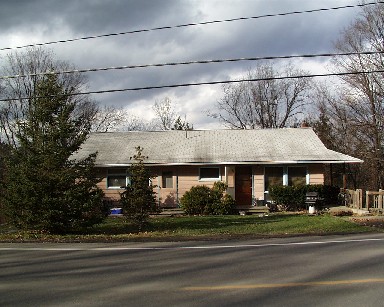
1200 Dryden Road (map)
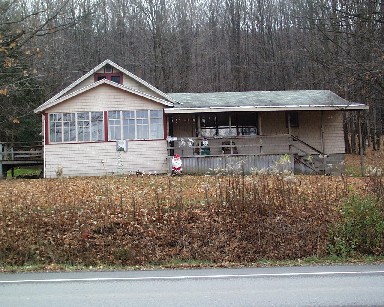
1199 Dryden Road (map)
December 27, 2003
Mysterious dart
There's an unusual dart in the Ithaca Journal today:
DART: From Scott Campbell of Dryden. To whoever cut down the fir tree in my front yard last week. The tree was planted by a longtime family friend in memory of my father. If you had asked honestly, and needed it that badly, we would have let you have it. No matter how altruistic your aims may be, your means of accomplishing them were unethical and deeply disheartening.
I'm not sure what the story behind that one must be.
At our house, it was a rough year on the trees between our property and next door, and they lost a fine spruce. We need to sort out where the property line goes through, and then I'd like to clean up the weed trees (lots of sumac and box elder, both of which keep falling over) in between. Hopefully no DARTs in the paper will result.
December 28, 2003
When Route 13 moved
Whenever I look at a map of Tompkins County, I look for the distinctively-shaped intersection of Routes 13 and 366. Even if a map doesn't have road labels, it stands out pretty clearly. It wasn't always that way, however - Route 366 through Varna and Ithaca used to be Route 13, until they built the new road through Lansing.
I found a 1900 US Geological Survey map of Dryden. This excerpt of it shows the road structures around Route 13's current path:
You can click on the map for a larger (452KB) version.
The map doesn't have road labels, but a few things stand out, notably that there were more direct connections between Dryden Road and Lower Creek Road. Freese Road stands out with its sharp curve, but Monkey Run Road and Baker Hill Road both had their own circuitous paths to Lower Creek Road. The area where 13 presently runs is largely blank.
The current road map, taken from the Tompkins County Road Centerlines data, looks very different:
There's a lot more development, but the roads now focus on the new 13, and there are fewer crossings between 366 and 13 than there were between 366 and Lower Creek Road. Baker Hill Road now halts at 366. (A dead end stub of it runs to some buildings, but a No Trespassing sign marks its end quickly.) Monkey Run Road is shown going through, but that road is not in service - big plow turnarounds and gates lead to a wide trail. There's lots and lots of new development on the western edge of this map, though that's largely Lansing and Ithaca.
It's also interesting to note how the roads around Etna and over Mt.Pleasant have changed very little. (I don't think Mineah Road, the easternmost road on these maps coming south off 13, goes through currently, however.)
If you want to see this in a more recent USGS map rather than the unadorned centerlines, similar information (and a lot more!) is available in a 1978 USGS map.
December 29, 2003
Open government
It seems to have been a quiet weekend in Dryden, or at least there's nothing in the paper. That seems best for a holiday weekend.
The Journal's lead editorial, on openness in the City of Ithaca government, though, reminds me of some controversies here from four years ago, just as I was moving into the town.
The way I remember it, Mark Varvayanis was campaigning on an open government platform, and suggested putting the Dryden Town Board minutes on the web site. Jim Schug, supervisor at the time, said he couldn't see why anyone would want to read the minutes on the web site. Even though I wasn't doing anything like this weblog at the time, it crystallized my opposition to Schug and the Republicans and I was very happy to be moving into a town that had elected Varvayanis.
The Town of Dryden Minutes page shows the results of that, though it looks like fewer and fewer boards have kept up. I'm also not sure how far back they're preserving, and I hope they keep everything available, since issues often take years to develop.
There aren't yet any minutes posted for December's Town Board meeting, though hopefully that just reflects the holidays and not the incoming board.
(And yes, I'd like to see major changes to the Town of Dryden site, and I'd even be willing to volunteer work on it if there was a chance of improving it.)
Turkeys
I went out to take some photos of Robertson Cemetery, on Baker Hill Road, and was surprised by an army of turkeys marching behind the NYSEG building.
December 30, 2003
State Police hiring
Of course, you already knew that if you'd driven Route 13 North toward the Village of Dryden lately - it's hard to miss the big flashing sign. The Ithaca Journal has details.
Robertson Cemetery
I knew there was an old cemetery around the corner from me on Baker Hill Road, but I hadn't visited it until yesterday. It's apparently the oldest cemetery in Dryden, having opened in 1802. It's been pretty well documented by local genealogists, but it's a strange place well-worth a visit. These pictures don't really convey the feel of the place, with its undulating ground, toppled headstones, and the strangely contrasting view out over the industrial and office zone at the intersection of Routes 13 and 366.
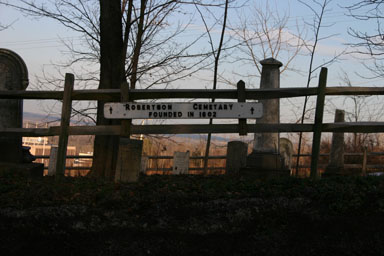
Robertson Cemetery, Baker Hill Road (map)
A lot of the headstones shown signs of having been shot, probably by hunters chasing the deer who leave clear evidence of their presence in the cemetery.
December 31, 2003
The Robertsons
Robertson Cemetery appears to be named for Captain George Robertson and his family. Robertson was the first permanent settler, the first town supervisor, and seems to have been a rather benevolent man as well, according to George Goodrich.
Chapter V
The First Resident Freeholder
While Amos Sweet was the first man to take up residence in Dryden, he seems never to have held permanent title to any of its real estate, and, so far as we can learn, he left no relatives or descendants from whom the present inhabitants can trace their ancestry. We know not whence he came, except from the "Old Man in the Clouds," who says that he came from "the East somewhere," and our short story of his appearance and residence here is an unsatisfactory and tragic one. We have already given all the facts which we can learn of him except the statement derived from an old obituary notice of Seth Stevens, a relative of the early Rummer family in Dryden, which states that Stevens, while probably residing in Virgil, helped to build the first log house in Dryden, presumably the Amos Sweet house. We have accidentally come across his signature as a witness to an old Dryden deed, which shows that he could write, an accomplishment at that time none too common.
The next settlement in the town was made by a man whose life had a permanent influence upon the town, and who well-earned the title which was afterward given him of being the "Father of the Town," having been its first resident freeholder and afterward its first supervisor.
In the year 1797 there lived near Schuylerville, Saratoga county, N.Y., George Robertson, a young carpenter and millwright, who by patient industry had acquired a home and a little property, but whose ambition prompted him to become a pioneer in the undeveloped wilderness of the Military Tract. His father, Robert Robertson, who had recently died, had in 1769 emigrated with his family, consisting of his wife, Josephine, and two small children, young George and his older sister, Nancy (McCutcheon) from near Glasgow, Scotland, to Saratoga county, where, upon the breaking out of the Revolution, the father enlisted and gallantly served throughout the struggle for independence. The old flint-lock musket which he carried in the army of Washington under the command of General Philip Schuyler, by and after whom one of his sons was named, is still kept as a treasure in the family and was on exhibition at Dryden's Centennial Celebration.
Young George Robertson, in 1797, had an opportunity of purchasing Lot No. 53, of Dryden, from a neighbor, Benoni Ballard, the soldier to whom it was allotted, and in the autumn of that year he made a prospecting tour on foot from Saratoga county to Dryden, reaching Lot 53 by way of the Mohawk Valley, Auburn, Cayuga Lake, and Ithaca, returning by way of the Bridle Road through the present site of Dryden village to Oxford, and thence by way of Utica to his home. Upon this preliminary visit the only habitation which he found in Dryden was that of Amos Sweet, described in the last chapter, where, as he related, there was a clearing of about half an acre which he called a "turnip patch."
Being pleased with the new country and possessed of a courage which, we fear, would be lacking in these days of luxury and refinement, Robertson sold his home and which the proceeds completed the purchase of Lot 53 for eight hundred and fifty dollars. He left his wife and two children for the time being and set out in February 1798 with a sleigh loaded with such implements and provisions as could be carried, drawn by two yoke of oxen, for the long journey. He was accompanied by at least two young men, including his younger brother, Philip S. Robertson, and Jared Benjamin.
Of Philip S. Robertson we shall have occasion to say more hereafter as being one of the pioneers of the northwest section of the town, but of Jared Benjamin we shall say here, lest it be omitted hereafter, that he was then a lad sixteen years of age who had been apprenticed to George Robertson to learn the carpenter's trade and who was induced to accompany him into the wilderness by the promise of eighty acres of land, and who, during the journey and for the first year of the settlement, served as the housekeeper and cook of the party. He afterwards served as a solider from Tompkins county in the War of 1812, after which he journeyed and settled further west, but his son, Charles Benjamin, returned to Dryden and at one time occupied and enlarged the Dryden village tannery and afterwards built a tannery at Harford, one of the old buildings still standing there unoccupied near the railroad station; and his son is Chas. M. Benjamin, now one of the proprietors of the Ithaca Journal. Another of the descendants of this pioneer lad, Jared Benjamin, is Mrs. D. B. Card, of Dryden.
To return to our narrative, it is claimed by some that Walter Yeomans, and by others that Moses Snyder also accompanied George Robertson on this pioneer journey, but neither are mentioned in the first account, published forty years ago when the facts were more attainable, and either may have come a year or two later, although it is certain that both were early pioneers of Dryden from Saratoga county.
The pioneer party were three weeks on the journey, coming by way of the Mohawk Valley, Utica, Hardenburg's Corners (now Auburn), reaching Ithaca (then called "Markle's Flats,") where there were then three log houses, March 1, 1798. It took the whole of the next day to widen the Bridle Road through from Ithaca to Lot 53, upon which Mott J. Robertson, the youngest son of Captain George Robertson, now resides, so as to admit of the progress of the team and baggage. They arrived towards evening on March 2nd and made hasty preparations to spend their first night on the site of their new home. In later years Captain Robertson pointed out to his sons the very spot, now located between the highway and the railroad track near the west line of Lot 53, where, on that March evening, on split basswood logs, they ate their first meal and stretched themselves out to spend the night, having provided the oxen with the tops of the basswood trees for a supper of browse. A fall of two inches of snow during the night caused Philip S. to get up and stretch over them a blanket on stakes, to protect them from the storm. The next morning the men set to work to build a log house and make a clearing so as to secure a crop of grain that season. The trees were chopped down, girdled and burned, the seed was dragged in with the aid of a tree top as a harrow, and the rich, mellow, new ground yielded abundant harvests in that and the succeeding years. Thus the energy and prudence of young George Robertson enabled him to harvest the first considerable crops in the town, and when the subsequent settlers came to him to obtain seed grain, it is said that he supplied those who had no present means of paying for it, but refused those who had money which would enable them to get it elsewhere, lest he should not have enough to supply all his poorer neighbors. Whether such a policy of supplying only those who had no money could be successfully carried out in those times, may be seriously questioned, but it served to exhibit the unselfish character of Capt. Robertson and entitled him to the gratitude of his fellow pioneers, as well as to that of their posterity. His wife and children came on, the next season (1799), in care of her brother, Wm. Smith, of Saratoga, who, after viewing the uninviting prospect of the single log house, surrounded for a short distance with the clearing full of charred stumps and then by the dense wilderness, advised his sister to return with him to his home in Saratoga, but she bravely resolved with her husband to share the hardships and reap the rewards afforded to pioneers in a new country. Their son, Robert R., whose birthday was April 7, 1800, was for a long time supposed to have been the first white child born in the town of Dryden, but we now learn upon reliable authority that Melinda, the daughter of David Foote and the mother of Mrs. Darius Givens, was born at Willow Glen, on February 21, 1800, and was therefore the first native-born child, while Robert R. was the first native-born male citizen of the town.
The heroic and unselfish conduct of Captain Robertson, and his industrious and prudent life, together with abilities of no common order, gave him prominence in our early history and when the town came to be organized as a separate political township in 1803, he was made its first supervisor. Although not the first settler, he was the first resident freeholder of the town, raised the first crop of any account, and, his house being a hospitable refuge for the early settlers perhaps less provident than he had been, he is credited with being the first innkeeper of the town in 1801. These facts well entitled him to be regarded, as he was by the early settlers, the "Father of the Town of Dryden." He was afterward a captain of the State militia and the field opposite the present residence of his son, Mott J. Robertson, upon which this log house was built in 1798, was the training ground for the early yeomanry of Dryden, who were here required to be annually drilled in military tactics. Captain Robertson died April 4, 1844, having raised a family of thirteen children, many of whom have held positions of honor and trust in this and other states, at least two of his sons having served as sheriffs of the county of Tompkins. His oldest child, Nancy, married Thomas Bishop and she and her oldest brother, Thomas, lived and died in the town of Lansing. Robert died in Chautauqua county, N.Y. Phoebe became the wife of Peter V. Snyder, and Corilla the wife of Wm. Brown, who, with her brothers John, Theodore, Cyrus, and Hiram D., made their home in Albion, Mich., and Philip died in Crawford county, Pa. Smith, of whom we shall say more hereafter, resides at Eau Claire, Wis., and Mott J., the only son now residing here, is one of the present Centennial Committee of the town of Dryden.
Goodrich, George B. The Centennial History of the Town of Dryden, 1797-1897. Dryden: Dryden Herald Steam Printing House, 1898. Reprinted 1993 by the Dryden Historical Society. Pages 13-17.
(The Dryden Historical Society, which sells this book, may be reached at 607-844-9209.)
